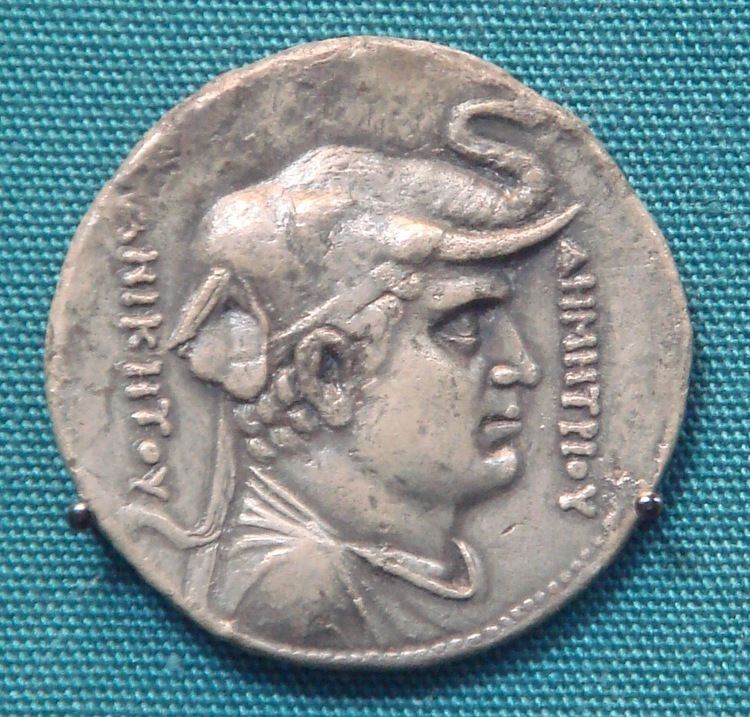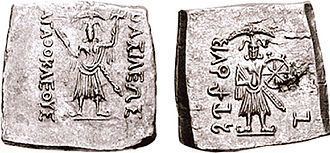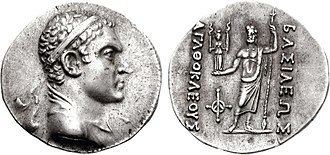Reign 190–180 BC Name Agathocles Bactria | Died 170 BC | |
 | ||
People also search for | ||
Agathocles of Bactria
Agathocles Dikaios (Greek: Ἀγαθοκλῆς ὁ Δίκαιος; epithet meaning: "the Just") was a Greco-Bactrian/ Indo-Greek king, who reigned between around 190 and 180 BC. He might have been a son of Demetrius and one of his sub-kings in charge of the Paropamisade between Bactria and India. In that case, he was a grandson of Euthydemus whom he qualified on his coins as Βασιλεὺς Θεός, Basileus Theos (Greek for "God-King").
Contents
- Agathocles of Bactria
- Pedigree coinage
- Dynast or usurper
- Nickel coins
- Bilingual coinage
- Buddhist coinage
- Hinduist coinage
- References

Agathocles was contemporary with or a successor of king Pantaleon. He seems to have been attacked and killed by the usurper Eucratides, who took control of the Greco-Bactrian territory. Little is known about him, apart from his extensive coinage.

Pedigree coinage

Agathocles issued a series of "pedigree" dynastic coins, probably with the intent to advertise his lineage and legitimize his rule, linking him to Alexander the Great, a king Antiochus Nikator (Greek: "Νικάτωρ" "Victorious", probably intended is Antiochus III), the founder of the Greco-Bactrian kingdom Diodotus and his son Diodotus II, Euthydemus, Demetrius and Pantaleon. On these coins, Agathocles labels himself ΔΙΚΑΙΟΥ, "The Just".
Dynast or usurper?
The pedigree coinage has been seen as a token of his ancestry, but a critical view might be considered. All the associations provide a contradictory image. The Euthydemid kings (Demetrius and Euthydemus) are not known to be related to Diodotus – in fact, Euthydemus I overthrew Diodotus II. The Seleucids were enemies of the Euthydemids as well – king Antiochus III had besieged Bactra for almost three years before claiming victory over Euthydemus I. However, Antiochus III did not take the territory and after Euthydemus I sent his son Demetrius in an envoy to him, he recognized them as the rightful kings in Bactria. Antiochus III is known to have used the epithet "Nikator" ("Νικάτωρ" Greek for "Victorious").
Finally, the association with Alexander was a standard move for usurpers in the Hellenistic world, such as the pseudo-Seleucids Alexander Balas and the Syrian general Diodotus Tryphon.
All in all, the coins might well support the view of a usurper, or more probable a member of a minor branch of a dynasty, anxious to gather support from all quarters with his various memorial coins. However, the similarities between his coinage and that of Pantaleon make it probable that Agathocles was indeed a relative of the latter, who in that case might have been a usurper as well.
Obverse – Greek inscription reads: ΑΛΕΞΑΝΔΡΟΥ ΤΟΥ ΦΙΛΙΠΠΟΥ i.e. "of Alexander son of Philip".
Reverse – Greek inscription reads: ΒΑΣΙΛΕΥΟΝΤΟΣ ΑΓΑΘΟΚΛΕΟΥΣ ΔΙΚΑΙΟΥ i.e. "of Reign Agathocles the Just".
Obverse – Greek inscription reads: ΔΙΟΔΟΤΟΥ ΣΩΤΗΡΟΣ i.e. "of Diodotus the Saviour".
Reverse – Greek inscription reads: ΒΑΣΙΛΕΥΟΝΤΟΣ ΑΓΑΘΟΚΛΕΟΥΣ ΔΙΚΑΙΟΥ i.e. "of Reign Agathocles the Just".
Nickel coins
Also, Agathocles and Pantaleon, along with their contemporary Euthydemus II, are unique in the ancient world, in that they were the first in the world to issue copper-nickel (75/25 ratio) coins1, an alloy technology only known by the Chinese at the time (some weapons from the Warring States period were in copper-nickel alloy2). These coins are indicative of the existence of trade links with China around that time (see Greco-Bactrian kingdom). Copper-nickel would not be used again in coinage until the 19th century in the United States.
Bilingual coinage
At the same time, Agathocles issued an intriguing range of bilingual coinage, displaying what seems to be Buddhist as well as Hindu symbolism. The coins, manufactured according to the Indian standard, using either Brahmi, Greek or Kharoshthi (a first in the Greek world), and displaying symbols of the various faiths in India, tend to indicate a considerable willingness to accommodate local languages and beliefs, to an extent unseen in subsequent Indo-Greek kings. They may be indicative of the considerable efforts of the first Indo-Greek kings to secure support from Indian populations and avoid being perceived as invaders, efforts which may have subsided once the Indo-Greek kingdoms were more securely in place.
Buddhist coinage
The Buddhist coinage of Agathocles is in the Indian standard (square or round copper coins) and depicts Buddhist symbols such as the stupa (or arched-hill symbol), the "tree in railing", or the lion. These coins sometimes use Brahmi, and sometimes Kharoshthi, whereas later Indo-Greek kings only used Kharoshthi.
Hinduist coinage
The Hinduist coinage of Agathocles is few but spectacular. Six Indian-standard silver drachmas were discovered at Ai-Khanoum in 1970, which depict Hindu deities. These coins, discovered on 3 October 1970 hidden in a pilgrim’s water-vessel in a room of the administrative quarter of the Greco-Bactrian city of Ai-Khanoum, are key to the understanding of the evolution of Vaisnava imagery in India.
These seem to be the first known representations of Vedic deities on coins, and they display early Avatars of Vishnu: Balarama-Sankarshana with attributes consisting of the Gada mace and the plow, and Vasudeva-Krishna with the Vishnu attributes of the Shankha (a pear-shaped case or conch) and the Sudarshana Chakra wheel. According to Bopearachchi, the headdress is actually a misrepresentation of a shaft with a half-moon parasol on top (chattra), as seen in later statues of Bodhisattvas in Mathura. It is therefore thought that sculptures or images, predating the coins but now lost, served as models to the engravers.
The frontal pose of these deities is totally uncharacteristic of the general depiction of Gods on Greek coins, who are generally shown in three-quarter postures. The sideways disposition of the feet is also characteristic of early India sculptures, as seen in the stupas of Bharhut or Sanci. This leads specialists to think that these images are the work of Indian engravers, who were familiar with the style and conventions of archaic Indian art.
The dancing girls on some of the coins of Agathocles and Pantaleon are also sometimes considered as representations of Lakshmi, the consort of Vishnu, but also a Goddess of abundance and fortune for Buddhists, or Subhadra, the sister of Krishna and Balarama. She is also seen in the Post-Mauryan coinage of Gandhara, on Taxila coin which is thought were minted by Demetrius I following his invasion.
These coins from Ai-Khanoum are a precious indication of the forms taken by the Bhagavata cult and Vaishnavism in early India, and shows that this cult was already popular in the area of Gandhara around the 2nd century BCE. The first known inscription related to the Bhagavata cult was also made by an Indo-Greek, an ambassador of king Antialcidas, who wrote a dedication on the Besnagar pillar in the 2nd century CE.
This popularity suffered a drastic decline when the Kushan Emperor Vima Kadphises proclaimed on his coins in the 1st century AD his worship of Shiva.
